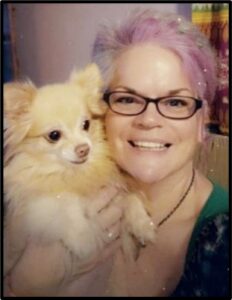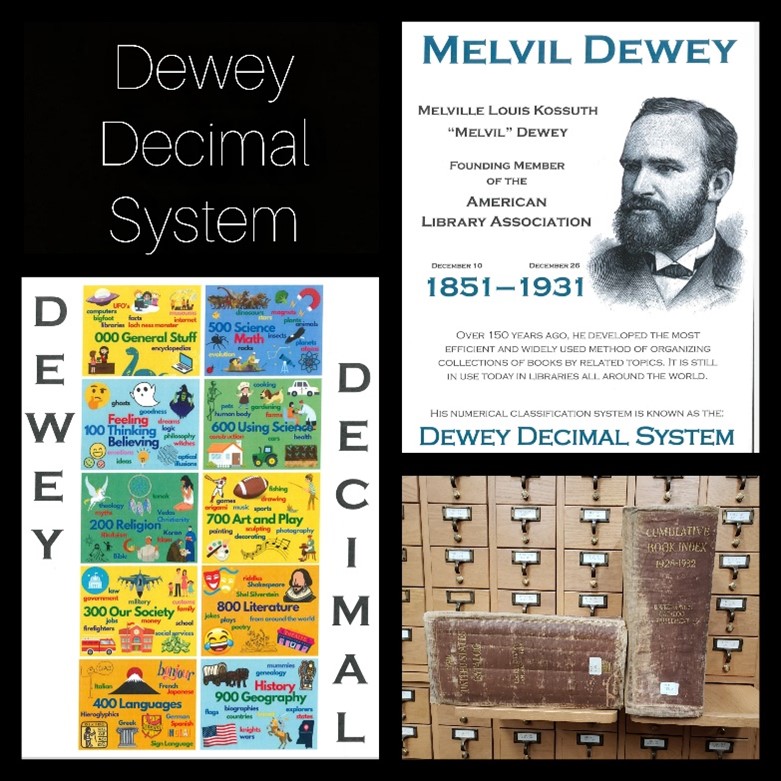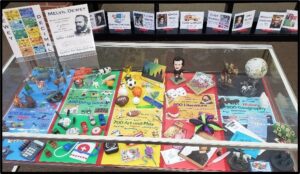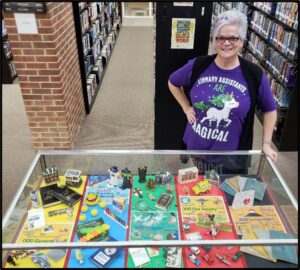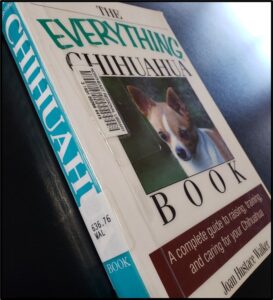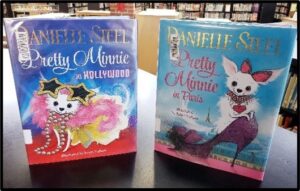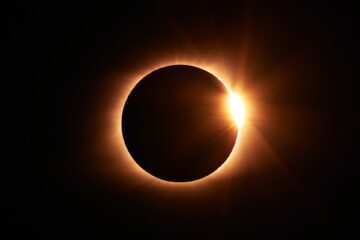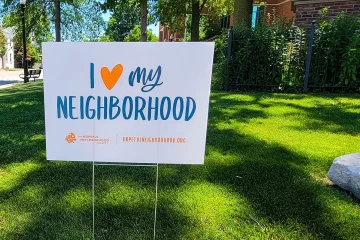Dabbling with Dewey
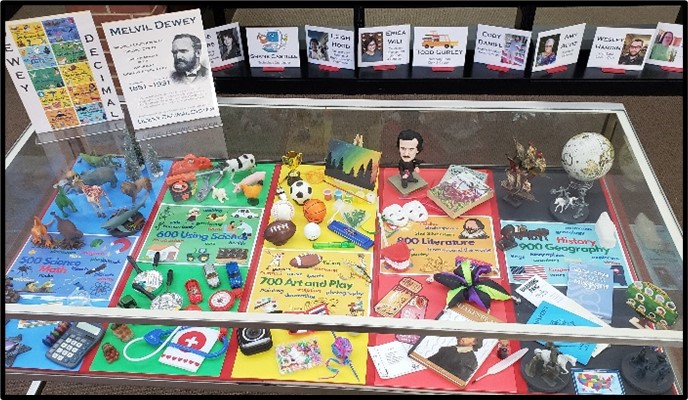
Part 1: What It Is
Okay, my friends, please bear with me as we dabble just a little with how the Dewey Decimal System came to be… once upon a time, there was no rhyme or reason regarding how book collections were organized. They were simply assigned a permanent shelf location that was loosely determined by the date of acquisition. As more and more books were made and added to collections, people bound their “shelf lists” into book catalogs.
By the mid-1800s, the pages of these bound catalogs were becoming so cluttered with over-written additions that they were barely legible. As a result, a system of using individually handwritten cards to catalog the growing collections was beginning to take shape. Melvil Dewey, a founding member of the American Library Association, further developed this concept in the 1870s to organize books by assigning a numerical value to related categories and subcategories.
As such, the Dewey Decimal System opened up shelf access to the public in large part because its use ensured that each book was returned to the correct place on the shelf. A book’s call number is much like a person’s home address- it identifies a space on a shelf like a house on a street, a street in a city, and a city in a state. The hundred number before the decimal point represents ten categories, which are divided into ten classes, each being divided again into ten subjects.
The numbers after the decimal point further break down the topics into specific types of information, followed by the first few letters of the author’s last name. At its inception, the Dewey Decimal System included fiction literature in the 800s category, but most modern public libraries worldwide shelve fiction and nonfiction separately. Fiction is organized in alphabetical order by the author’s last name, while the numerical decimal system continues to be used to organize nonfiction collections.
Part 2: Making Sense of It
Are you still with me? I hope so because this is where it gets a little interesting for me. But first, I’d like to tell you why I was inspired to put together a display about something as seemingly mundane as the Dewey Decimal System. When I started working at the library, I was a bit overwhelmed by the nonfiction section. I mean, it’s HUGE! How was I ever going to learn everything I thought I needed to know about this often overlooked and underutilized area of my library?
And then I discovered that I really don’t need to KNOW it all, I just had to be able to FIND it all. How was I going to do that, you might ask? By understanding the Dewey Decimal System, of course! Now, because I am a visual person, I started seeing the categories and classes in color with dimension and life. I mapped out in my mind a display full of “things” that represent the EVERYTHING that nonfiction is, and I went on a treasure hunt to find them.
I dug through my grandkids’ toy boxes. I borrowed things from coworkers. I searched through boxes I had already sealed for donation. I went to thrift shops and dollar stores. And for the things I could not find, I made. Let me tell you, I was on a mission… the hunt was on and I was enjoying every minute of it- I’m still so tickled by some of the treasures I ended up with! Now, if you were to ask me what my favorite category is, I honestly cannot tell you.
What I can say is this: the hardest one to put together was the 400 Languages. I mean, how do you represent “words” with dimension and color? Well, I found a little charm that says “I love you” in sign language (the most universally understood language in the world) and made one in hieroglyphics (the oldest written language in the world). Check them out… they are hung on the red heart in the center of “I love you” written in languages from around the world. I think they are precious!
Part 3: How It Applies
So, what does any of this mean for you? It means that you can have a look at the displays and see if something sparks your interests. Search the topic in our online catalog to get the “address” (call number) and read up on any topic that tickles your fancy. Want to learn how to make or save money? There is a coin bank that indicates this topic can be found in the 300s. Interested in sports? Check out all the balls in the 700s. What about dinosaurs? There are a lot of them in the 500s!
For example, there is a little puppy in the 600s. I put it there because she kind of resembles my little long-haired chihuahua, Rosie, who is absolutely the sweetest thing ever! Out of curiosity, I searched the online catalog and found “The Everything Chihuahua Book” by Joan Hustace Walker. The call number is: 636.76 WAL. So, let’s break down those numbers as they are assigned in the DDS…
And there it is… information about chihuahuas! Once you are there, you can easily find other books about different types of farm animals if you want to. Information about cattle/cows is numbered 636.2. Pigs/swine fall under the 636.4 decimal. And all things relating to domesticated cats is 636.8. Is that making more sense now? Easy breezy once you make the connection, right?
As you can well imagine, there are books about everything and public libraries needed a way to sort and organize all of this information. The Dewey Decimal System continues to be what we use here at the Corinth branch of Northeast Library. Now, like I said before, you do not need to know what all of the numbers mean but isn’t it at least somewhat interesting to see a snapshot of what the wonderful world of nonfiction is actually made up of?
Part 4: Having Fun with It
In closing and just for giggles, I will leave you with the following fun fact: when I was searching for a book about chihuahuas, I discovered this one by Danielle Steel as well. It is located at 818.54 STE (Category 800: Literature; Class: American Literature in English; Subject: American Miscellaneous Writings; Types and Subtypes: Written Between 1945-1999; Author: Steel). The other photo is of MY sweet Rosie.
Okay, so first of all, who knew that Danielle Steel, one of the world’s best-selling authors of all times has a long-haired chihuahua- just like me?! And second, isn’t their resemblance uncanny? My mind was blown! Then, get this- she wrote not one, but two children’s books about her favorite fur-baby! I was completely starstruck, or maybe dumbstruck (haha!), but either way, I checked these books out just so I could introduce her Pretty Minnie to my Precious Rosie.
- Note: although Danielle Steel is best known as a fiction romance writer, this particular book is cataloged as nonfiction because it is a true story about her dog. And the children’s books are shelved with other early reader picture books
So now that all is said and done, aren’t you glad you stayed with me as I went down this rabbit hole? Please do not answer that… lol! Seriously though, I really do hope that some how or in some way, the Dewey Displays have sparked a degree of curiosity or helped you make a connection with some thing you can find some where on the shelves of our nonfiction area. If not, go have another look… I’m sure you can find a treasure of your own to hunt for!
